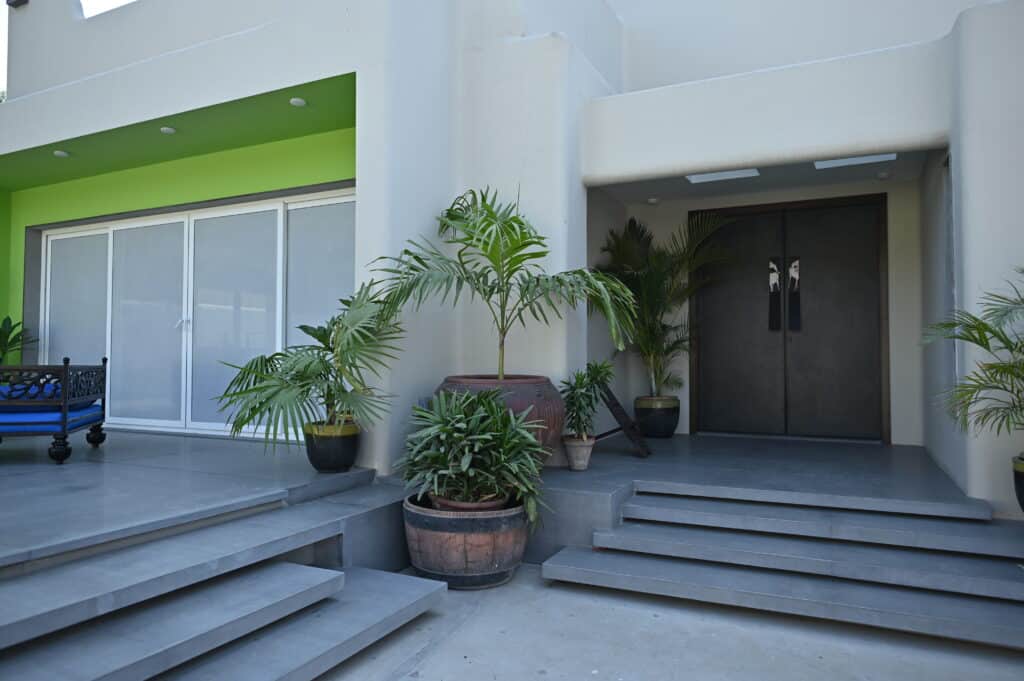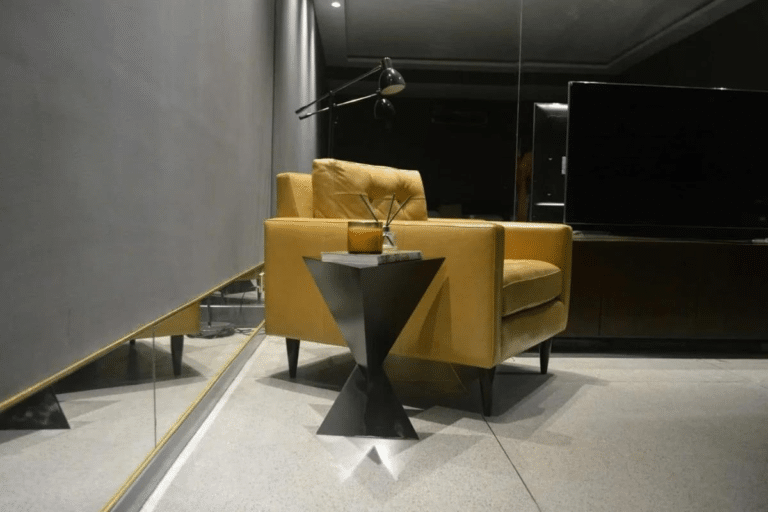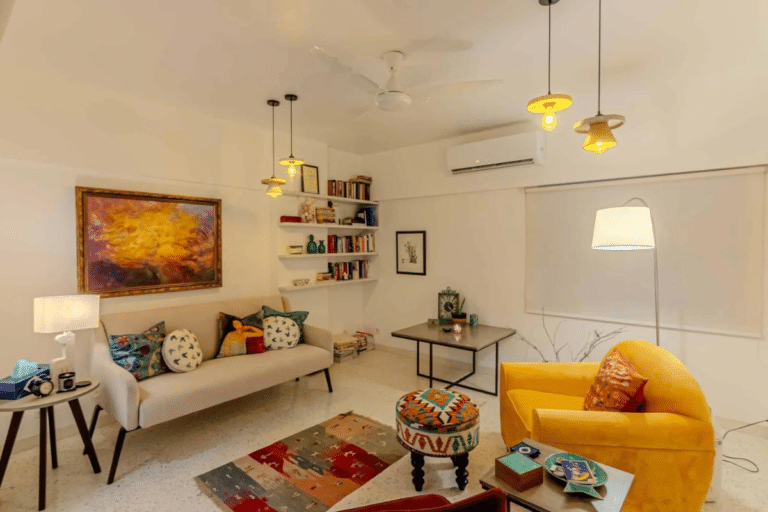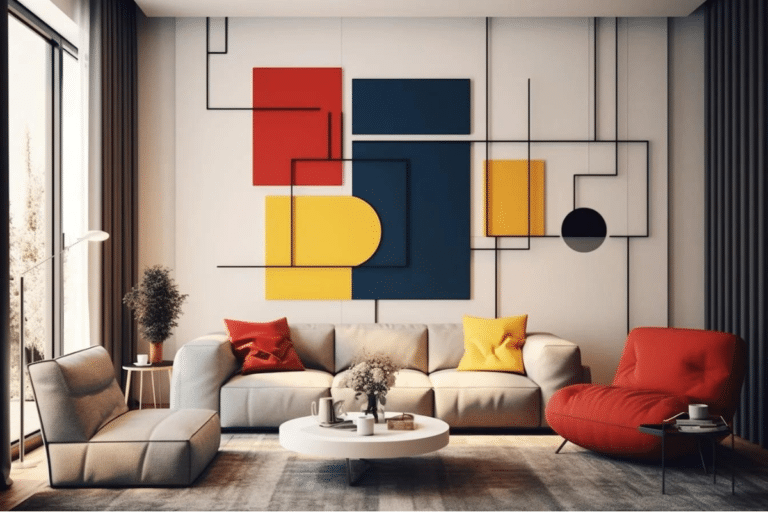Have you ever walked into a room and instantly felt calm or energized? Or maybe a room’s color just rubs you the wrong way? It’s not just your imagination! Colors are powerful tools that can influence our moods, productivity, and even our well-being. This is where the fascinating world of color psychology in home interior design comes in. Think of your home as a blank canvas. The colors you choose are like brushstrokes, painting a mood for each space. So, before you grab a can of paint, Colors play a significant role in shaping the feel and functionality of your home. Here’s how they subtly influence your interior design:
Mood Setting: Different colors evoke different emotions. For example; Blue creates a calming and serene atmosphere so it is an ideal pick for bedrooms and bathrooms while red energizes and stimulates, often used in dining rooms or kitchens.
Perception of Space: Colors can alter how you perceive the size of a room. Light Colors make a space feel larger and more open. So, if you have a small room or a place with limited natural light, you should pick lighter colors to make your space look spacious and roomy. Likewise, Dark colors create a cozy and intimate feel, suitable for large rooms.
Harmony and Flow: Using a consistent color scheme throughout your home can create a sense of unity and flow. Complementary Colors opposite on the color wheel create vibrant and energetic spaces while analogous Colors i.e. next to each other on the color wheel provide a harmonious and relaxed feel.
Functional Areas: Colors can help define different areas in an open-plan space. A different color on one wall can highlight specific areas, like a reading nook or dining space. Using different colors for different functional zones helps in distinguishing areas like the kitchen, living room, and workspaces.
Psychological Impact: The psychological effects of color can influence behavior and feelings. For instance, the Green color is associated with nature and it promotes relaxation and tranquility.
Light Interaction: The way colors reflect or absorb light affects the ambiance of a room. Glossy finishes reflect more light, making rooms feel brighter. Matte finishes absorb light, creating a more subdued and cozier atmosphere. By understanding these principles, you can use colors to subtly control the ambiance and functionality of your home, making it a more enjoyable and efficient space.
Psychology of Colors
Studying how colors affect us is fairly new, but people have always been interested in their power. In ancient times, colors were used to heal and affect emotions, and they were important in spiritual practices. Why do colors have such a strong impact on us? How do they affect our bodies and minds? While people see colors differently, some effects are universal. Colors like red, orange, and yellow are called warm colors. They can make us feel cozy and happy, but they can also cause anger or hostility. Colors like blue, purple, and green are called cool colors. They often make us feel calm, but can also bring feelings of sadness or indifference.
let’s learn about the psychology of some key colors and how they can affect you and your
home interior design:
Yellow: Yellow is a color of nature. Let the sunshine in! Yellow gives the vibe of cheerfulness and optimism. It can boost your mood, spark creativity, and make a small room feel more spacious. Think dandelion yellow for a kitchen nook or a sunshine yellow accent wall in your home office. You can use different variants of yellow to make your home interior design look and feel lively.
Orange: If you are feeling sluggish then Orange is like a burst of energy. It can increase alertness, stimulate conversation, and encourage physical activity. So, if your living room feels a bit dull, an orange rug or some citrusy throw pillows might be the pick-me-up it needs.
Red: The color of passion and excitement, red can get your heart racing (literally!). It adds drama and can make a space feel more intimate. However, a little goes a long way. Too much red can be overwhelming, so use it sparingly as an accent wall or with bold throw pillows.
Blue: The ultimate symbol of peace and tranquility, blue is a natural choice for bedrooms and bathrooms. It can promote relaxation, lower blood pressure, and help you unwind after a long day. Try a calming sky blue for your bedroom walls or a refreshing teal for your bathroom.
Green: Breathe easy with the color green. Associated with nature, green fosters feelings of calmness, harmony, and balance. It’s a great choice for creating a serene living room or workspace where you can focus. Think about a soft sage green for your living room walls or a leafy green accent chair in your home office.
Purple: Dive into luxury with purple. It evokes feelings of royalty, creativity, and wisdom. While a bold purple might be too much for an entire room, a rich plum accent wall in your dining room can create an elegant and sophisticated atmosphere.
White: White is a blank slate, offering a sense of cleanliness, purity, and spaciousness. It pairs well with any color and can be a great choice for small rooms that need some brightening up. However, too much white can feel sterile, so add warmth with textures and wood accents.
Gray: Sophisticated and timeless, gray strikes the perfect balance between stark white and dark black. It creates a sense of calm and can be a great backdrop for bolder colors. Play with different shades of gray for a layered look, or use it as a base for pops of color with artwork or throw pillows.
Black: Black adds drama and sophistication to any space. Use it sparingly as an accent wall or with furniture to create a sense of grounding and definition. Black can also make other colors pop, so it’s a great way to highlight your favorite artwork or rug.
Remember, It’s All About You! While color psychology offers great guidelines, it’s important to consider your own preferences. Do certain colors evoke happy memories for you? Do you find particular shades energizing or calming? Let your personality shine through! Here are some tips for incorporating color psychology into your home: Think about the function of the room. Do you want a space to be energizing or calming? Consider the mood you want to create when choosing your color palette. Some people are lively and energetic so they can choose vibrant colors like yellow, orange, and pink that give a funky vibe to the home interior design while people with decent personalities can use neutral colors to redefine their space.
- Don’t be afraid to experiment! Sample paint colors on your walls before committing to a whole room. You can also use temporary solutions like throw pillows or rugs to test out whether a certain color scheme goes well with your home interior design.
- Let light play a role. Natural light can affect how colors appear. Consider the amount of natural light a room gets when choosing your paint colors.
- Embrace the power of accents! You don’t have to paint your entire walls in a bold color. Use throw pillows, artwork, rugs, and furniture to add pops of color and create a cohesive look.
Few Tips to Use Basic Color Theory for Interior Design
Choose Any Color: Start by picking a color that suits the mood or purpose of the space. Use color psychology to match the ambiance your client wants. Then, use the color wheel to find a complementary color.
Dark to Light Vertically: Apply the dark-to-light method vertically in a room. Use darker colors for the floors, medium tones for the walls, and lighter shades higher up to create an illusion of height and space.
Consult the Color Wheel: The color wheel helps you determine which colors work well together. If you’re unsure about color pairings, refer to the wheel to find complementary colors.
Incorporate Grays: Gray is a versatile neutral that fits many styles, from modern to Victorian. Pair it with vibrant colors to create a balanced and stylish look.
Follow the 60-30-10 Rule: Use 60% of a dominant color for walls, 30% of a secondary color for upholstery, and 10% of an accent color for accessories. This rule ensures a balanced and harmonious design.
Balance Warm and Cool Colors: Neutrals can be paired with both warm and cool tones to create a balanced space. For example, mix gray with warm honey tones for a cohesive look.
Incorporate Personal Style: Take inspiration from your client’s personal style to create a unique design. Whether their style is modern or Victorian, use it to guide your color choices.
Use Colors Based on Emotions: Choose colors that evoke the desired emotions. For example, dark purples can convey richness and luxury, while light blues can create a calming atmosphere. Different colors have different emotional impacts, so select them based on the mood you want to create.







